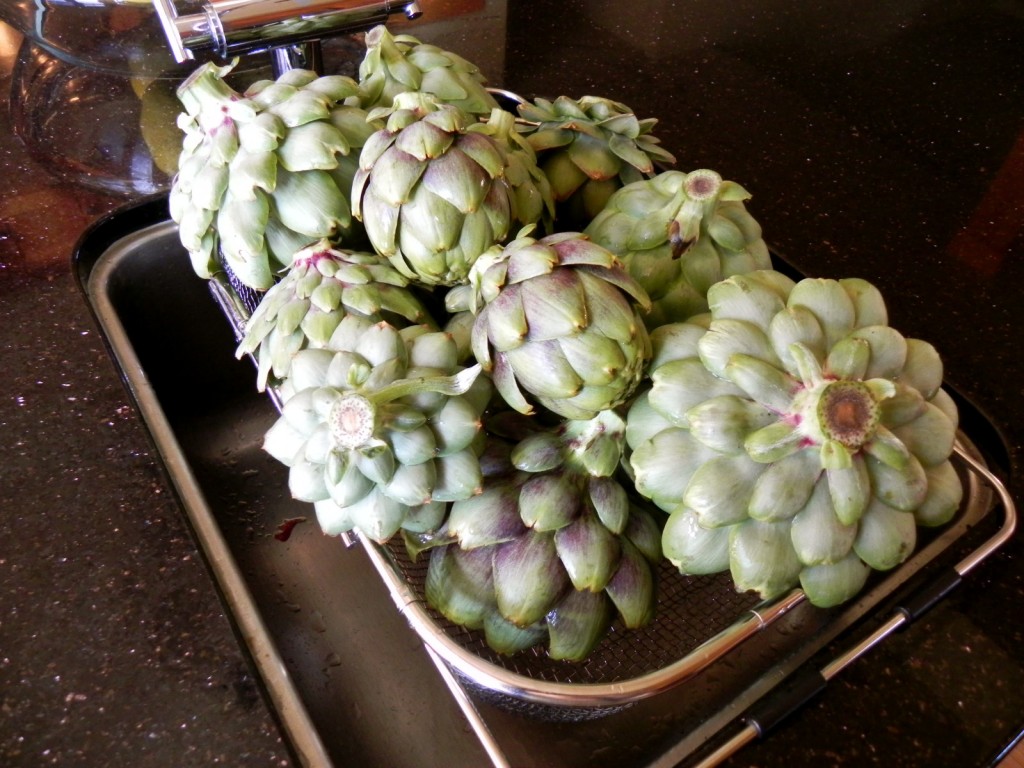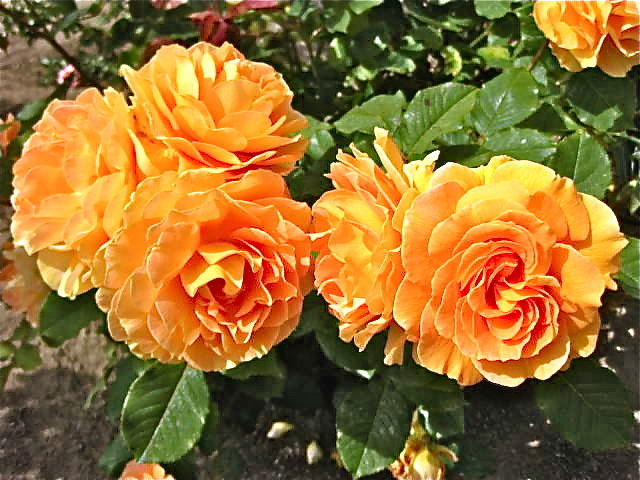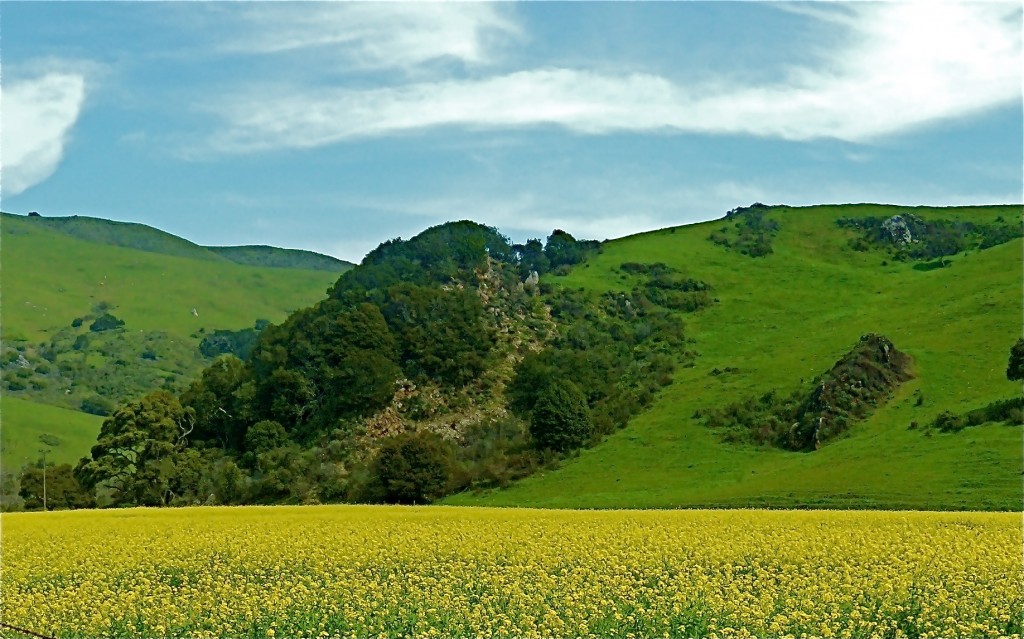
We got a real “mother load” of artichokes this year. Maybe it was all the rain. Maybe it was a fact that these plants are now two years old, mature enough to have high yields. Whatever the reason, our artichoke plants soared to five feet in height and have born beautiful blooms continually for the past month.The artichoke (Cynara scolymus) is in the sunflower family. I wrote about my first year harvesting artichokes (here) but this year was spectacular and I’ve learned a few things.
First of all if you live inland, it may be too hot in the summers for this tender perennial. Our cool humid days along the coast is the perfect climate for artichokes, as witnessed by the huge fields along the coast of San Francisco and Monterey Counties. Buying the rootstock is the fastest way to get a crop but I had great luck starting my plants from seeds indoors, then transplanting them outside when they were a few inches high. Add plenty of organic matter and slow-release fertilizer to your soil and provide supplementary water. These tough plants will grow in vacant lots with little water, but their blooms will be woody. Not something you’d want to eat, so be sure your plants get a moderate amount of water.
Clean up the dead leaves that appear at the bottom of the plant as they turn yellow. Cut them off with loppers and not tearing it off so that you don’t pull out some of the developing shoots. According to some local growers, you can cut the plant down to the ground after it has finished blooming. Let it rest a few weeks, then begin watering again. You may get a nice fall crop. I’ll try that this year but my plants are still producing and I’ll let them do their thing first.
I haven’t had problems with aphids but I know that artichokes are susceptible to them. I do have a problem with earwigs that crawl into the scales of the bloom. I soak the harvested blooms in water with a tablespoon of salt for a half an hour before putting the blooms into boiling water to cook. I boil artichokes for about 45 minutes until tender in the center when a fork is inserted. The earwigs usually abandon ship in the first rinse so I’ve never encountered an earwig on my plate. Thank goodness!

We make an easy dipping sauce for our artichokes. This is enough for four large artichokes. I take about 1/2 cup of mayonnaise, 2 tablespoons of fresh lemon, 1/2 tsp. cumin, and a sprinkle of salt and mix it and serve it in a small dipping bowl beside each dish. Half the fun of eating artichokes is dipping the thick end of each leaf into the dip and biting or scraping the flesh from the leaf. When you get to the heart, you need to remove the hairy center with a spoon. You are then rewarded with a large, sweet morsel of artichoke “meat”. Paradise!



Hi!
I have Three huge Artichoke plants that have finished producing. It is only the middle of May and I want to know if I will kill the existing root stock if I cut the plants down to the ground now?
Hi Floyd,
When you have harvested all the artichokes on the plant, you can leave it but it will not produce more flowers and will slowly die down. I cut mine down to the ground. You’ll see little side shoots coming out. These will be your new plants. We get artichokes again in late summer from these new shoots. Have fun! You really can’t hurt these beautiful plants!
This is my first year planting artichokes. I planted them in 2 week of april how low does it take to grow and how do you now when it ready?
My artichokes grow to maturity in about 6 months. If you are in a warm climate it will take less time. Harvest the blooms when the scales begin to open. You can cut off a few at at time. No need to wait until all are ready. Some will be ready before others so cut them as they mature. Mine produce a second harvest that are smaller but still delicious. Then they die down and new sprouts come up from the ground.
I live in a very hot climate…Central Valley of CA. and our plants are on their third year and are doing amazingly. They are gorgeous and have given us fantastic artichokes, so I don’t see any problem growing them inland at all. Bon Apetit!
What a monster plant! I have three that I grew from seed in the fall and they are budding like crazy now. How big should I let them get before I start harvesting? They are currently about half the size of the ones I see in the grocery store. I have a recipe for baby artichokes but I don’t want to cut premature. Can you help?
How wonderful. Artichokes should be harvested before the scales open up and form a flower. The younger they are, the more tender. We wait until they are nice and big, like the ones you see in the market. The outer leaves are a little tough, we just discard. I like the big heart in the larger ones. Yummmmm!
i live at 5000′ elevation. my artichoke plants are healthy with the exception of ants farming a;phids. the problem is that the bracs are opening prematurely. any suggustions?
Oh, too bad. Are they opening up before when they are small? 5000 feet means you get snow, right? I don’t think artichokes can survive a hard freeze. They are normally grown along the coast. Now, about those aphids. Squirt them off. They are sucking the strength out of the plant. When a plant is attacked like that, it can mean it is not thriving for one reason or another. Don’t spray with poison or you will kill all the good predators that feed off of aphids. Wishing you the best. Let me know if you finally get some full size artichokes!
Hello,
We are in inland southern california, zone 9. We have one year old artichokes that were never cut back last winter. We’ve concluded our abundant harvest of rather small but tasty artichokes in late May. Did overwintering (not cutting them back to the base in late fall) cause the smaller chokes??? When the artichokes are cut back, does the whole stock get cut? Cut below the soil? Is there a particular angle of the cut? Any hints on the way to get larger chokes in a future harvest? Thanks a bunch!!
I’m so sorry it has taken so long to get back to you. We’ve traveled to Amsterdam and took a river cruise. Meanwhile, my garden burst forth and the artichokes grew quite large on some plants this year even though I was unable to water because of our water restriction in Cambria. Maybe this will help you.
I cut or break off the big leaves as they begin to wither after producing the artichokes. I harvest the artichokes as they mature, a few at a time. When the plant begins to die down, you’ll usually see new growth coming from the main stump. All old growth can be removed at this time. The plants look a bit pathetic but they are producing new growth from the main branch from the previous year. This would be a good time to fertilize with a 10-10-10 and give the plant a good watering. I try to water a bit in the summer (maybe once a month) to keep the plants looking descent.
Does this help, Lisa? Please feel free to ask more questions. Artichokes are the closest to weeds we have in the garden so don’t be afraid to cut them back. They’ll return! Good luck!
Did I pick my artichokes too soon? The leaves were opening up when I picked them so I figured they were ready – this is their first year.
I boiled them for about an hour until the leaves were falling off, but they were not tender, and the heart was good. What went wrong?
My artichokes are small this year. About 4″ across. They are opening up. The ones that we picked before they opened were quite tender. I boiled them about 45 minutes. I’ll pick some that have opened slightly and cook them to see if they are tough, like yours. I’ll let you know.